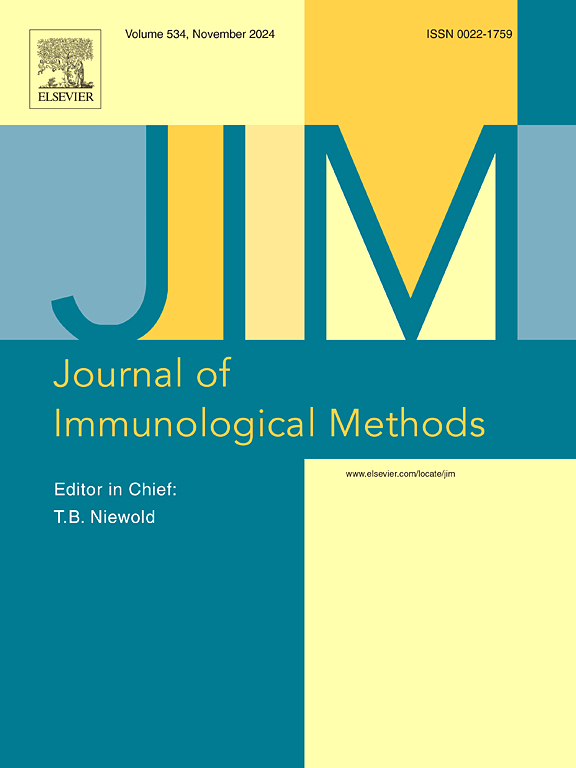A novel variation of the mixed lymphocyte reaction for measuring T cell responses to skin-specific antigens of pigs
IF 1.6
4区 医学
Q4 BIOCHEMICAL RESEARCH METHODS
引用次数: 0
Abstract
Skin and vascularized composite allografts (VCA) containing skin are transplanted to restore form and function of tissues after major injuries. Skin has long been recognized as being particularly immunogenic, causing high risk of rejection and immune sensitization. Due to skin-specific antigens, donor skin is often rejected even in animals that are tolerant of the remaining donor tissue. To study the reaction of lymphocyte subsets against these minor and/or tissue-specific skin antigens in swine made tolerant to allogeneic donors through hematopoietic stem cell transplants (HSCT), we developed a skin-adapted variation of the mixed lymphocyte reaction (MLR). We processed porcine skin into single cell suspensions to be used as stimulators. Peripheral blood mononuclear cells were used as responders. We first optimized the concentrations of skin stimulators to achieve T cell proliferation with minimal self-background reactivity. The assay was then tested in two pigs that had received combined VCA/HSCT. The first pig had not rejected any part of the VCA, and the second pig was actively rejecting the epidermis of the VCA at the time of the assay. Despite lack of anti-donor MLR responses against donor lymphocytes in the peripheral blood in either animal, the second pig demonstrated a specific response against donor skin cells. Our results suggest that the assay will be useful to study recipient sensitization against skin antigens, even in otherwise tolerant animals. This assay may have both diagnostic and therapeutic implications for immune responses specific to the skin.
混合淋巴细胞反应的一种新变异,用于测量猪皮肤特异性抗原的T细胞反应。
含有皮肤和血管化复合同种异体移植物(VCA)的皮肤移植用于修复重大损伤后组织的形态和功能。长期以来,人们一直认为皮肤具有特别的免疫原性,导致排斥反应和免疫致敏的风险很高。由于皮肤特异性抗原的存在,即使在对剩余的供体组织具有耐受性的动物中,供体皮肤也经常被排斥。为了研究通过造血干细胞移植(HSCT)对异体供体产生耐受的猪的淋巴细胞亚群对这些次要和/或组织特异性皮肤抗原的反应,我们开发了一种混合淋巴细胞反应(MLR)的皮肤适应变异。我们将猪皮加工成单细胞悬浮液用作刺激剂。外周血单核细胞作为应答者。我们首先优化了皮肤刺激剂的浓度,以实现T细胞增殖与最小的自身背景反应性。然后在两只接受了VCA/HSCT联合治疗的猪身上进行了检测。第一只猪没有排斥VCA的任何部分,第二只猪在试验时积极排斥VCA的表皮。尽管在这两种动物的外周血中都缺乏针对供体淋巴细胞的抗供体MLR反应,但第二只猪对供体皮肤细胞表现出特异性反应。我们的结果表明,该试验将有助于研究受体对皮肤抗原的致敏性,即使在其他耐受的动物中也是如此。这种检测方法可能对皮肤特异性免疫反应具有诊断和治疗意义。
本文章由计算机程序翻译,如有差异,请以英文原文为准。
求助全文
约1分钟内获得全文
求助全文
来源期刊
CiteScore
4.10
自引率
0.00%
发文量
120
审稿时长
3 months
期刊介绍:
The Journal of Immunological Methods is devoted to covering techniques for: (1) Quantitating and detecting antibodies and/or antigens. (2) Purifying immunoglobulins, lymphokines and other molecules of the immune system. (3) Isolating antigens and other substances important in immunological processes. (4) Labelling antigens and antibodies. (5) Localizing antigens and/or antibodies in tissues and cells. (6) Detecting, and fractionating immunocompetent cells. (7) Assaying for cellular immunity. (8) Documenting cell-cell interactions. (9) Initiating immunity and unresponsiveness. (10) Transplanting tissues. (11) Studying items closely related to immunity such as complement, reticuloendothelial system and others. (12) Molecular techniques for studying immune cells and their receptors. (13) Imaging of the immune system. (14) Methods for production or their fragments in eukaryotic and prokaryotic cells.
In addition the journal will publish articles on novel methods for analysing the organization, structure and expression of genes for immunologically important molecules such as immunoglobulins, T cell receptors and accessory molecules involved in antigen recognition, processing and presentation. Submitted full length manuscripts should describe new methods of broad applicability to immunology and not simply the application of an established method to a particular substance - although papers describing such applications may be considered for publication as a short Technical Note. Review articles will also be published by the Journal of Immunological Methods. In general these manuscripts are by solicitation however anyone interested in submitting a review can contact the Reviews Editor and provide an outline of the proposed review.

 求助内容:
求助内容: 应助结果提醒方式:
应助结果提醒方式:


